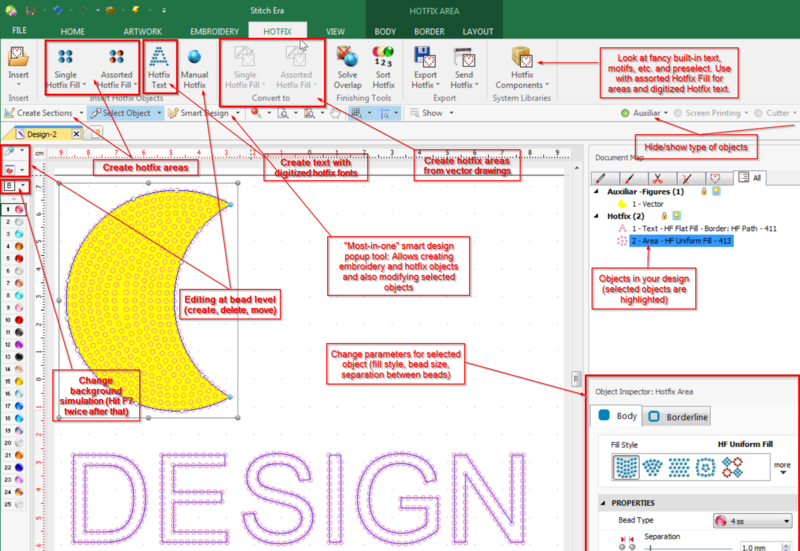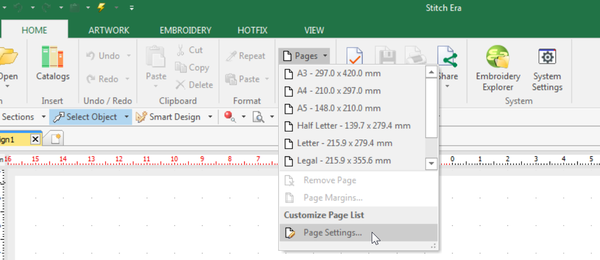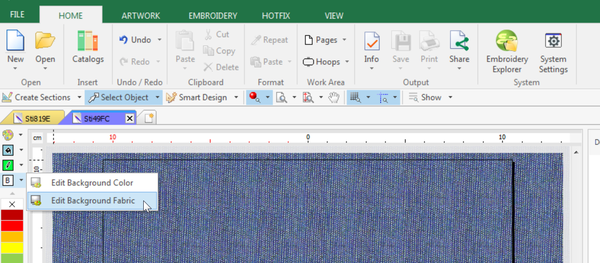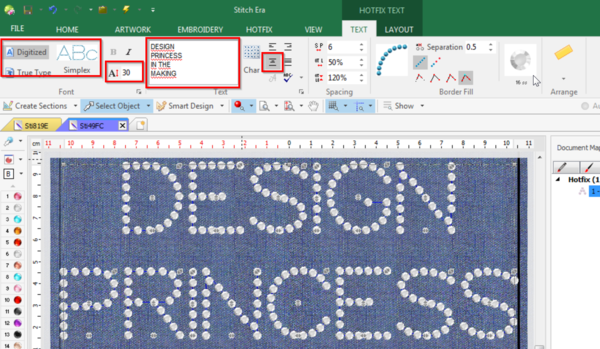Stitch Era - creating hot fix designs: Difference between revisions
| Line 127: | Line 127: | ||
[[file:stitch-era-17-hotfix-area-parameters.png|thumb|800px|none|Vectors graphics to hotfix (dark yellow moon)]] | [[file:stitch-era-17-hotfix-area-parameters.png|thumb|800px|none|Vectors graphics to hotfix (dark yellow moon)]] | ||
== | == Creating hotfix designs with digitized letters == | ||
You can create letters in different ways: | You can create letters in different ways: | ||
* Hotfix lettering | * Use Hotfix lettering functionality of which exist two variants: | ||
** Digitized fonts, i.e. fonts that are specially created for hotfix (recommended) | ** Digitized fonts, i.e. fonts that are specially created for hotfix (recommended) | ||
** True type fonts that you can fill either along the borders, inside the fills, or both | ** True type fonts that you can fill either along the borders, inside the fills, or both | ||
Revision as of 15:28, 18 October 2017
Introduction
This beginner's tutorial for the Stitch Era embroidery software explains how to create designs for hotfix stones.
- Tutorial home page
- Stitch Era embroidery software
- Learning goals
- Be able to import vector graphics files
- Be able to digitize a vector graphic
- Prerequisites
- Stitch Era embroidery software and Stitch Era - creating embroidery from vector images (in particular, be able to create a design defined by vector graphics).
- Related pages
- none
- Materials
- You can reuse the pictures. In the wiki, click on picture to make it larger, then click again and save it.
- Quality and level
- This text should technical people get going with Stitch Era. I use it for an optional master degree course in educational technology.
- Last major update
- October 2017.
Stitch Era includes an extension module that allows creating hotfix design templates (also called rhinestones or strass). It allows filling areas with holes for hotfix stones according to various parameters. The design then can be sent to a vinyl cutter or a laser cutter to creating a template.
The principle for creating a hotfix design is the same as creating embroidery areas. Instead of filling with a stitch patterns, areas will be filled with "beads", i.e. circles that position each bead.
Thereafter, as explained in the hotfix stone article, you could use different methods to place the beads. You can:
- Manually set the stones with an applicator (a kind of soldering iron with a special tip)
- Print the design on paper, put the stones in place on the paper, apply a transfer sheet to top or transfer. (Alternatively put the transfer sheet sticky part on top over the paper and put the stones with the tips down ?)
- Use a template, then as above a transfer sheet. It will allow handling designs with hundreds of stones fairly easily.
- Use a stone setting machine (various types exist)
The template method
We will use the template method. With Stitch Era you can create a vector design (e.g. SVG or DXF) and cut out the holes with a laser cutter or a cutting plotter. Typically you would use 0.5mm cardboard or heat resistant textile. Below, we quote the procedure from an older version Stitch Era V11 manual (retrieved oct. 2017), with slight modifications.
The key of this method is to create templates or stencils. Since you cannot easly sort out different sizes and colors beads, you need one template for each different piece (different size, shape and color) your design uses. A template is a rigid plate with a set of small deep (0.5 mm) depressions or marks, arranged according the design, in the places where the hotfix pieces should be set. Marks have to be of the same shape of the piece they are intended for, but a bit larger.
The idea is to spread a handful of hotfix pieces over the template and to let them to become trapped in the marks. This happens because hotfix pieces have a flat side (the back) and a round side (the front). So, they become trapped with the shining side up. Usually, a soft brush (e.g. foam) is used to drag the beads over the template until all marks are occuped. Then, a sheet of transfer material (with the adhesive toward the pieces) is pressed by hand against the template. When the transfer sheet is removed from the template, all beads are attached to it. The transfer sheet is then placed on the garment placed in a heat press with the adhesive toward the garment. One also could use an iron, hower the result may not be as good.
Hotfix can send files directly to some plotters and laser cutters. Instead we export to SVG that we will modify a bit before sending it to the laser cutter, i.e. in our setting the cutting lines must be red (RGB 255,0,0) and have 0.01mm width. If not done in Stitch Era we also will have to add a cutting rectangle with some margin and adjust the size of the whole print.
Stitch Era will automatically make the holes a bit bigger. E.g. an SS16 (3.8 to 4mm) stone will be represented with a 4.5mm circle, i.e. it will add 0.3mm (dec mm) to the 1.95mm typical radius of an SS16. This setting can be changed in File tab, Preferences setup -> Application -> Project -> Hotfix -> Hotfix cutting margin.
If you don't own a cutting plotter or laser cutter, you may use a cardboard around 0.5 mm thick and drill on it holes a little larger than the beads, e.g. for an SS16 (4mm) use 4.5mm . You may use a Hotfix Era printout of the design 1:1 scale as a reference. Then you need to stick the drilled cardboard to another cardboard piece of the same size. The template will be ready to use.
Different design methods
As for embroidery, Stich Era offers a whole range of design path. Functionality can be different according to software level. Here we will discuss a version we obtained for our students and that is integrated within Stitch Era.
As with embroidery you could start designing from a raster image or from vector drawings. On the hotfix side, you can draw highlevel objects and fill them according to various choices and parameters or you can work at the bed level. The moon below was created as vector graphics and then filled with hotstones, using the "Single Hotfix Fill" pull-down menu in the middle (see below)
.
In the ribbon menu, there are about four hotfix creation tools. From left to right:
- Two tools for creating hotfix areas by clicking in the workspace. Use the context menu (right click) to close a drawing and again to create it
- A button to manipulate individual beads (same as little pull down down menu on top of the beads palette)
- The text creation tool (will change the menu layout)
- The conversion tool from vector objects to hotfix areas
In addition in the main menu (below the ribbon menu bar), there are tools that allow doing the same, in particular the "Create Sections" and "Smart Design" pull-down menu.
On top of the beads palette you find three little pull down menus: The first two allow working at the beads level and one below allows defining a background picture.
As soon as you click on a hotfixed area in the workspace the interface will adapt its ribbons to it. E.g. clicking on text object will show hotfix text with two subtabs: text and layout.
.
Size and placement
Before designing we suggest defining a "paper size" or a "hoop size".
- Go to the
Home - Select
Pagespull down menu - Either select an existing page size or create a new one, and then select.
According to Danielle Petroskey's Ultimate Guide To Design Size & Placement (retrieved oct. 2017), below are the most common sizes and placements for T-shirts:
Placement of centered design
- Adult: 8-9cm (3–3.5)" down from the collar
- Youth: 5-7cm (2–3") down from the collar
- Toddler: 5cm (2") down from the collar
Typical Sizes of a design
- Adult: 28x28cm (11x11")
- Youth or small adult: 26x26cm (10.5x10.5")
- Youth (small): 21x21cm (8.5x8.5)
- Toddler: 14x14 (5.5x5.5")
You cannot do much wrong if you use a landscape A5 size (21 X 14.8 cm) or a 21x21 square. I.e. you can sketch a design on some ordinary portrait A4 office paper.
A really big size for an adult is about 30 x 35.5cm
Sizes and placements for hoodies are similar. Of course, you can apply hotfix stone designs in other areas, e.g. on the sleeves, down the front, on top of the back (similar as above), down the back, hip area, etc. The largest recommend size by Danielle Petroskey is 30.5x35.5cm (12x14)
Vector graphics to hotfix
As with embroidery, you can create hotfix designs by drawing or importing vector graphics. In sum, the procedure for translating to hot stones is the following.
- Create or import a drawing
- For each object make sure to define either a fill, a border or both.
- Open the hotfix tab
- Select one or more or all objects and select and fill option in the single hotfix fill or assorted hotfix fill menu in the middle of the hotfix menu bar
- This will create a hotfix object with default values
If you cannot see the result:
- Make sure to click on hotfix to the right in the menu bar (it must be green). At the same time, you could turn off "auxiliar", i.e. not show the vector drawings.
- Click on the lightning bar on top, i.e. generate the beads if its not done automatically (or F9 of FN-F9 on some windows machines)
Each hotfix object now can be reparametrized. Below we changed settings for the middle moon. We use SS20 stones and an "HF inner ring fill"
Creating hotfix designs with digitized letters
You can create letters in different ways:
- Use Hotfix lettering functionality of which exist two variants:
- Digitized fonts, i.e. fonts that are specially created for hotfix (recommended)
- True type fonts that you can fill either along the borders, inside the fills, or both
- Draw vectors, then digitize to hotfix (not discussed here)
Select size and background
Before creating a hotfix design we suggest turning on a simulation of the cloth and then also add a "page size", e.g. A5 landscape size as in the picture below.
Enter the text with a nice font
For beginners, it is probably better to start using a digitized font, i.e. objects that have all the beads positioned in an optimal way.
- Click on the Hotfix tab in the ribbon menu, the click on the
Hotfix Texticon. - Alternatively, in the Smart Design Popup, open the hotfix tab, and click on the Hotfix Text icon
In both cases you now should see the Hotfix menu bar. If it does not show click on the TEXT that shows on the menu bar.
- To the left, in the ribbon menu bar, select
Digitizedand then choose a font. - Enter the text in text area in menu bar (To add a new line, hit CTRL-Enter)
- Change size (30 in our case) and the alignment (middle in our case)
Change the rhinestone tone and size
You now should select the rhinestone size:
- Click on the rhinestone icon
- Select one from the popup menu.
Hotstone size are usually defined by 'SS measures. You can have a look at size definitions in the size table. For example:
- SS6 = 2mm
- SS10 = 3mm
- SS16 = 4mm
- SS20 = 5mm
If you size and color is not there, then click on add bed at the bottom. You will get a popup that will allow defining all sorts of colors, shapes and sizes. We chose SS16, standard shape and clear crystal color.
Now you could change many other parameters, but we find that the result is pleasing enough and will stop here.









